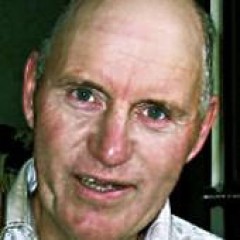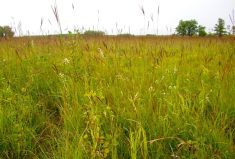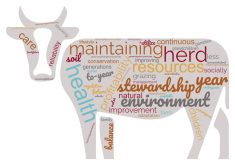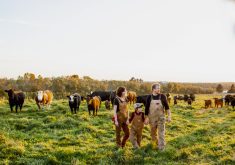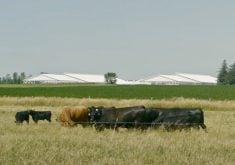Each year we are presented with an opportunity to graze our cattle in a manner that will improve our land, increase our profit and make us more sustainable. Planned grazing works. It has been shown to be beneficial under all environments. Planned grazing has the potential to increase or even double the production on a set land base. What impact would doubling your grass production have on your bottom line? Are you taking advantage of this knowledge to help you build a more profitable, more sustainable business? We are halfway through the 2014 grazing season but it is never too late to begin to do a better job.
Read Also

Body condition, nutrition and vaccination for brood cows
One of the remarkable events of the past century related to ranching has been the genetic evolution of brood cows….
Doubling grass production seems like a wild prediction. How can this be possible? Let me share some personal history. I was introduced to the concept of planned grazing in the mid-1980s. At that time I was a conventional rancher. I used continuous grazing and felt I was doing a good job, the best I knew how to do at that time. Planned grazing shifted my paradigms. I began to see that cows are tools to improve the land. I realized that proper grazing could improve the ecosystem building blocks. The result would be healthier land, increased production and increased profit. I have used planned grazing for the past 25 years. The result has been that my grass production has more than doubled on a ranch that I felt was under good management 25 years ago.
Planned grazing focuses on helping you achieve your landscape goal. Everyone would have a different goal in their own words and unique to their situation. A common theme might be “let’s leave the land better than we found it.”
The building blocks are energy flow, water cycle, mineral cycle and succession. Stop and think about it. Does anyone have trouble doubling grass production in an ideal year when growing conditions are excellent? I think we would all agree that this is commonplace. When we improve the ecosystem building blocks we help create more excellent years. Suddenly doubling the grass production makes sense. It is not some wild starry-eyed idea.
- More Holistic Ranching with Don Campbell: Seizing the opportunity
There are two main requirements to achieve healthier pastures. We need to stop the overgrazing and cover the bare ground. Overgrazing occurs when we graze too long at one time (graze period) or when we return for a second graze before the plants have fully recovered from the previous graze (recovery period).
Graze Period: Stopping overgrazing requires a short graze period. I suggest a graze period of three to five days to get started. Once you see the benefits of a short graze period you may choose to use an even shorter graze period. The rule of thumb is: the shorter the graze period the better. The graze period you decide to use will be based on your commitment to land improvement and your availability of labour.
Recovery Period: The recovery period is king. Plants must be allowed to fully recover from a graze before being grazed a second time. The best indicator that a plant is fully recovered is that it is ready to flower. Grazing a plant at this stage has no detrimental effects. In fact grazing at this stage is beneficial to the individual plant and to the ecosystem. The rule of thumb is: full recovery is essential. I suggest a recovery period of 60 to 90 days to start. You will need to experiment to find the recovery period that works best for you. My experience has been that as you move closer to 90 days your results will be better. In some of the drier areas grazing once a year may be the best choice.
Bare Ground: The ideal situation is to have no bare ground. Literally every inch of ground should be covered by a growing plant or litter (dead and decaying plant material). It is possible to double your effective rainfall by having no bare ground and soil with a high organic matter. Effective rainfall is defined as the amount of rain available for plant growth compared to total rainfall. When it rains some of the water runs off, some soaks in, and some is lost to evaporation. The rest is available for plant growth and this amount can be doubled with an effective water cycle.
Moisture is the limiting resource in most of Western Canada. What improvements would you see by doubling your effective rainfall? It is interesting how everyone talks about the rainfall and almost no one talks about the water cycle. Often when we talk about dry spells or drought we are really talking about an ineffective water cycle. We can’t change our rainfall but we can improve our water cycle. When we do this it has the same results as increasing our rainfall.
Another often overlooked part of planned grazing is the replan. Basically this means preparing a grazing plan before the growing season begins. Once growth starts we are constantly monitoring our regrowth (an indicator of growing conditions) and adjusting our management to match our growing conditions.
Planned grazing has three main components: it helps you achieve your landscape goal (what does your land need to look like to provide short-term profit and long-term sustainability?). It focuses on increasing the health of your land by improving the ecosystem building blocks. It allows you to adjust your management to match the growing conditions you are experiencing in the current year.
I hope this gives you cause for thought. Planned grazing works. It is based on sound proven principles. It has helped many people and it has the potential to help you. I encourage you to investigate planned grazing. I hope you have an excellent growing season. Happy trails.
Don Campbell ranches with his family at Meadow Lake, Sask., and teaches Holistic Management courses. He can be reached at 306-236-6088 or [email protected].

